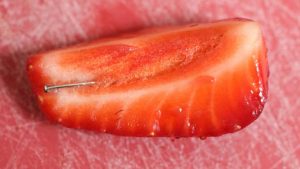As the needle-in-produce saga in Australia subsides, it has spread to New Zealand, probably by dim-witted copycats.
 Zoe Hunter of the New Zealand Herald reports a batch of blueberries has been removed from supermarket shelves after a Tauranga man believes he found a “rusty” thumbtack inside the small fruit.
Zoe Hunter of the New Zealand Herald reports a batch of blueberries has been removed from supermarket shelves after a Tauranga man believes he found a “rusty” thumbtack inside the small fruit.
The man, who would only be named as Mr Osborne, was celebrating his wife’s birthday at his mother-in-law’s home last night and took the last mouthful of his dessert when he bit into a thumbtack.
“Luckily I bit into it sideways and spat out the tack,” he said.
He believes the thumbtack was inside one of the blueberries that his mother-in-law used in her cake recipe.
“It seems pretty well thought out because when I pushed it into the side of the blueberry you couldn’t see it,” he said. “It was rusty and slightly bent.”
The man had learned blueberries were a good snack for dogs and he and his wife had just got a new puppy.
“Lucky I did not give it to my dog,” he said.
After the incident, Osborne put the blueberry and thumbtack inside a ziplock bag and notified supermarket staff, who he said had handled the complaint well.
 Osborne said his mother-in-law had bought the punnet of blueberries from Pak’nSave in Pāpāmoa on January 21.
Osborne said his mother-in-law had bought the punnet of blueberries from Pak’nSave in Pāpāmoa on January 21.
He had posted his find on Facebook to warn people about checking their fruit thoroughly before eating it.
A Foodstuffs spokesperson said the company had been notified about the incident and an investigation was under way.
“The batch has been pulled from store shelves and we are going through our stringent investigative process,” she said.
“The outcome of the investigation will be referred to the authorities for their review and support.”
The find was the latest in a series of sharp objects finds in produce around New Zealand.
Foreign objects in fruit and vege in 2018:
December: Pin found in strawberry bought at Pak’nSave Cameron Rd
November: Needle found in a capsicum bought at Countdown Bureta
November: Needle found inside a punnet of strawberries purchased at a supermarket in the South Island in November
September: Three needles found in three strawberries in one imported punnet of Australian Choice brand strawberries at Countdown St Lukes in Auckland
New Zealand Food Safety advice:
If you see something out of the ordinary, please take it to your retailer or give us a call on 0800 00 83 33.



